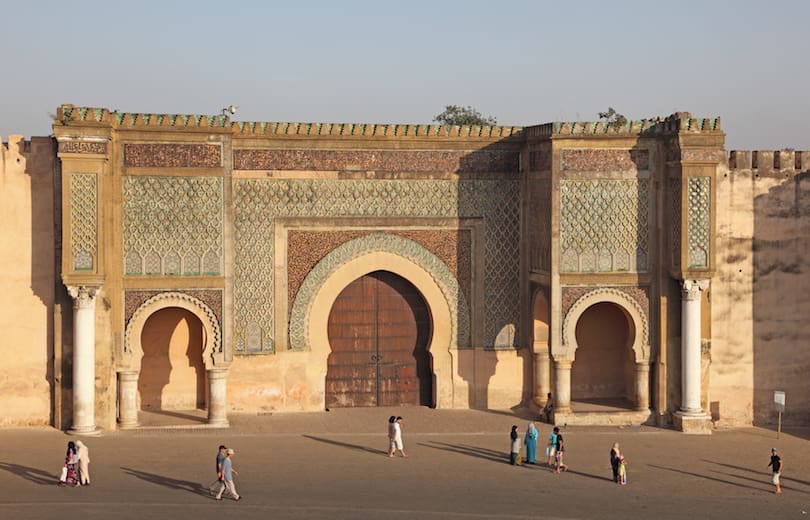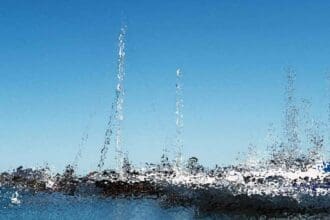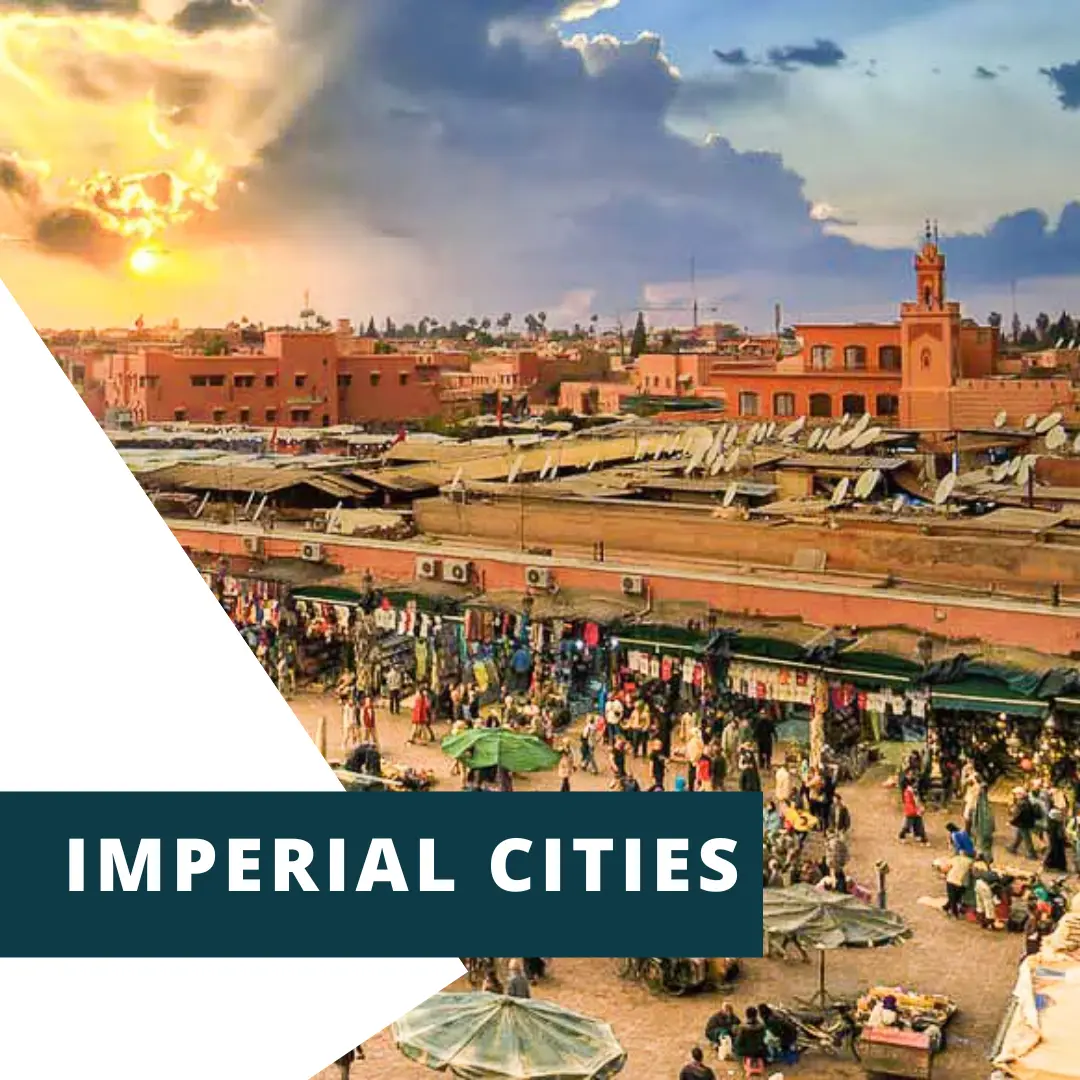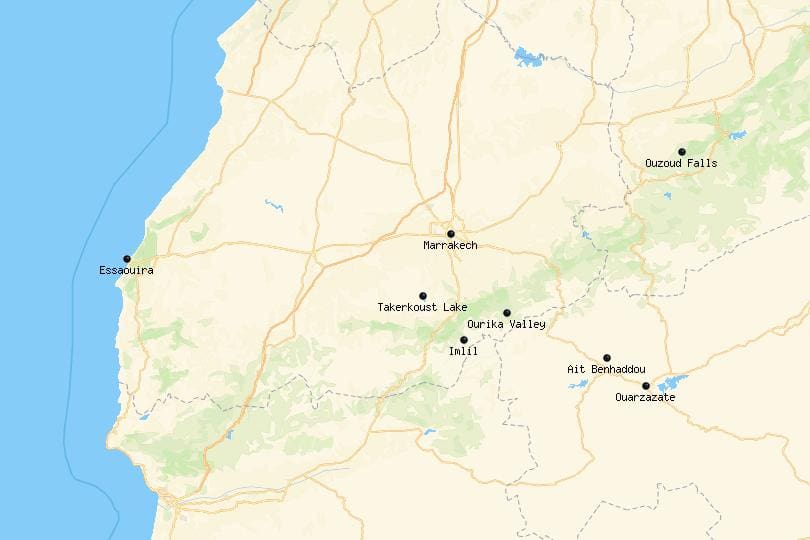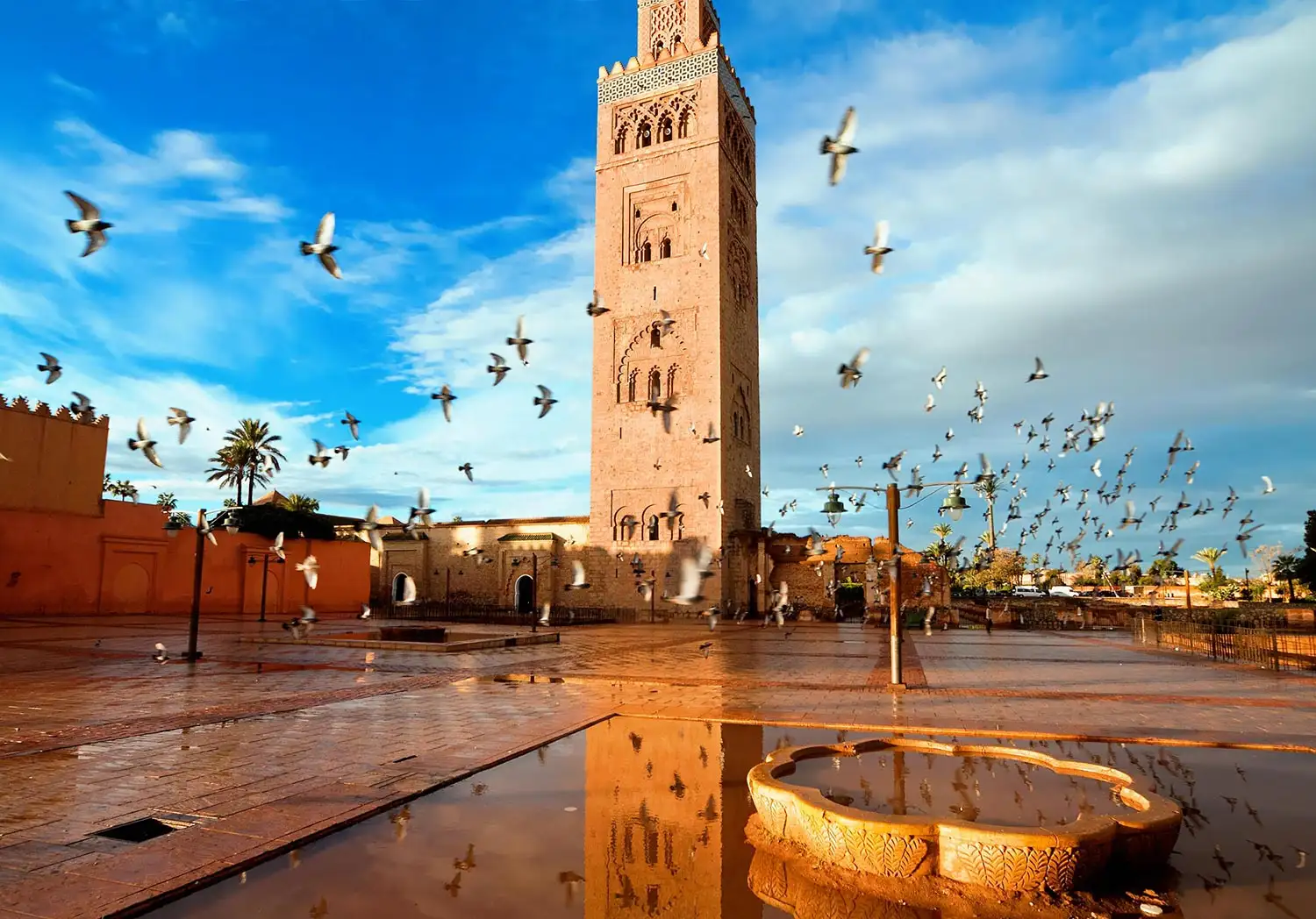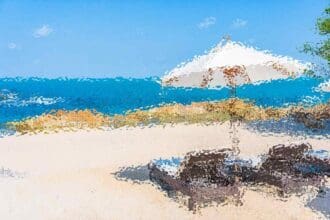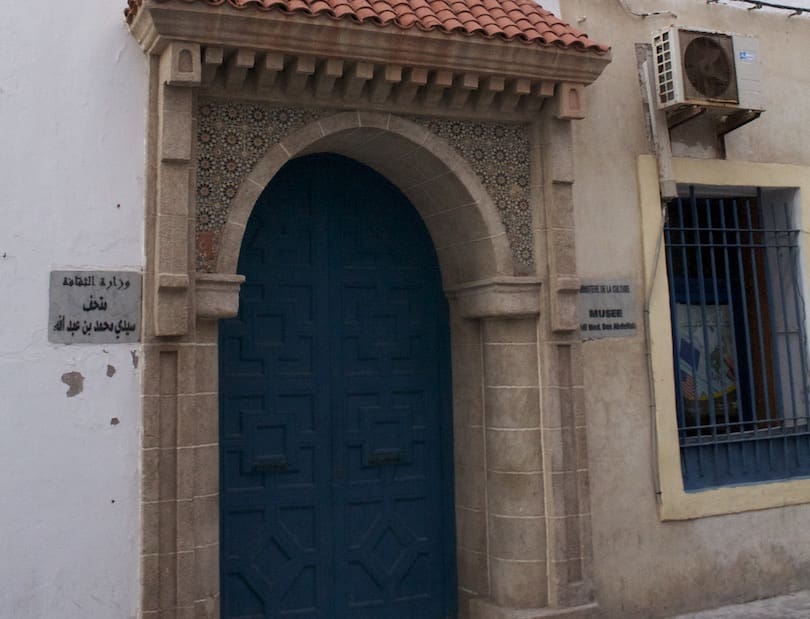Morocco is a land of contrasts, where ancient traditions blend seamlessly with modern life. From the bustling souks of Marrakech to the serene Sahara Desert, this North African gem offers an unparalleled experience for travelers seeking adventure, culture, and relaxation. Whether you’re a history enthusiast, a nature lover, or someone looking to immerse themselves in vibrant local customs, Morocco has something for everyone. In this comprehensive guide, we will explore the 17 top attractions and things to do in Morocco , ensuring that your journey through this enchanting country is unforgettable.
Discover the Magic of Marrakech: A Vibrant Cultural Hub
Marrakech is often referred to as the “Red City” due to its distinctive terracotta-colored buildings. This vibrant metropolis serves as the heart of Moroccan tourism, offering visitors an intoxicating mix of sights, sounds, and flavors. The city’s medina, a UNESCO World Heritage Site, is a labyrinth of narrow alleys filled with bustling markets, historic mosques, and stunning palaces. With its rich tapestry of experiences, Marrakech is one of the most essential destinations on any traveler’s itinerary when visiting Morocco.
Jemaa el-Fnaa Square: The Soul of Marrakech
At the center of Marrakech lies Jemaa el-Fnaa Square, a lively hub that comes alive at sunset. Street performers, musicians, and storytellers entertain crowds, while food stalls serve up mouthwatering dishes like tagine and grilled meats. For those who want to capture the essence of Moroccan culture, spending an evening here is a must. The square transforms into a sensory overload, where snake charmers weave their magic, henna artists create intricate designs, and vendors sell everything from fresh orange juice to traditional spices.
“The energy of Jemaa el-Fnaa Square is infectious—it’s like stepping into another world.”
This iconic square is not just a place to visit; it’s an experience that encapsulates the spirit of Marrakech. As night falls, the square becomes even more vibrant, with the aroma of freshly cooked food wafting through the air and the rhythmic beats of drums echoing off the surrounding buildings. It’s a place where locals and tourists alike gather to enjoy the spectacle, making it one of the top attractions in Morocco .
Koutoubia Mosque: Architectural Marvel
Standing tall above the cityscape, the Koutoubia Mosque is an iconic symbol of Marrakech. Its towering minaret can be seen from miles away, guiding travelers toward the city center. Built in the 12th century during the Almohad dynasty, the mosque is considered a masterpiece of Islamic architecture. While non-Muslims cannot enter the mosque, its exterior architecture and surrounding gardens are worth admiring.
The Koutoubia Mosque is not only a religious site but also a historical landmark that reflects the rich cultural heritage of Morocco. The minaret, standing at 77 meters (253 feet), was once the tallest structure in the Islamic world and served as a model for other famous mosques, including the Giralda in Seville, Spain. The lush gardens surrounding the mosque provide a peaceful retreat from the chaos of the city, making it a perfect spot for reflection and photography.
Bahia Palace: Opulence Redefined
For a glimpse into Morocco’s royal past, visit Bahia Palace. Built in the 19th century, this palace showcases exquisite craftsmanship, with intricate mosaics, carved cedarwood ceilings, and lush courtyards adorned with orange trees and fountains. The name “Bahia” translates to “brilliance,” and this palace lives up to its name with its opulent design and grandeur.
The palace was originally constructed for Si Moussa, the Grand Vizier of Sultan Hassan I, and later expanded by his son, Ahmed ben Moussa. It features 150 rooms, each decorated with stunning details that reflect the wealth and sophistication of Moroccan royalty. Visitors can wander through the palace’s many chambers, marveling at the intricate stucco work, colorful tiles, and lush gardens. The central courtyard, known as the Courtyard of Honor, is particularly breathtaking, with its symmetrical design and tranquil atmosphere.
Bahia Palace is one of the best things to do in Morocco for those interested in history and architecture. Its beauty and elegance make it a must-visit destination in Marrakech, offering a glimpse into the luxurious lifestyle of Morocco’s elite during the 19th century.
Explore Fes: A Journey Through Time
Fes is Morocco’s spiritual and cultural capital, home to one of the world’s largest car-free urban areas. The Fes el-Bali medina transports visitors back in time, with its maze-like streets, medieval architecture, and traditional way of life. Declared a UNESCO World Heritage Site, Fes el-Bali is a living museum that preserves the essence of Moroccan history and culture.
Al Quaraouiyine University: Oldest Still-Operating Institution
Founded in 859 AD, Al Quaraouiyine University holds the Guinness World Record as the oldest existing, continually operating higher educational institution. Located within the medina, this university has played a pivotal role in shaping Islamic scholarship and education for over a millennium. Although it remains closed to tourists, its library houses rare manuscripts dating back centuries.
The university’s library, known as Al Quaraouiyine Library, is a treasure trove of knowledge, containing some of the most valuable Islamic texts in the world. Among its collection are works on theology, science, and philosophy, many of which have been meticulously preserved over the years. The library underwent extensive renovations in recent years to ensure the preservation of these priceless documents, making it a vital resource for scholars and historians.
Chouara Tannery: Witness Ancient Craftsmanship
One of Fes’ most unique experiences is visiting the Chouara Tannery. Here, leatherworkers use age-old techniques to dye hides using natural pigments. Be prepared for strong odors, but don’t miss out on purchasing high-quality leather goods directly from artisans.
The tannery is located in the heart of the medina and has been in operation for over a thousand years. Visitors can observe the entire process, from soaking raw hides in lime pits to dyeing them in large stone vats filled with natural dyes made from plants, minerals, and animal products. The vibrant colors of the dyes create a striking visual contrast against the earthy tones of the tannery, making it a popular spot for photography.
Despite the pungent smell, the Chouara Tannery is a fascinating place to learn about traditional Moroccan craftsmanship. Leather goods produced here, such as bags, shoes, and jackets, are renowned for their quality and durability, making them excellent souvenirs to take home.
Sahara Desert Adventures: A Once-in-a-Lifetime Experience
No trip to Morocco would be complete without venturing into the vast expanse of the Sahara Desert. This otherworldly landscape offers endless opportunities for exploration and reflection. Covering nearly 9.2 million square kilometers, the Sahara is the largest hot desert in the world and a defining feature of Morocco’s geography.
Erg Chebbi Dunes: Golden Sands Under Starlit Skies
Located near Merzouga, Erg Chebbi’s towering sand dunes stretch endlessly across the horizon. These dunes, some reaching heights of up to 150 meters (492 feet), are a favorite among photographers and adventurers alike. Visitors can embark on camel treks during sunrise or sunset, camp under the stars in a Berber tent, or simply marvel at the shifting sands.
The experience of riding a camel through the dunes is both exhilarating and humbling. As you traverse the golden landscape, you’ll feel a profound connection to nature and the timeless rhythms of the desert. Many tours include overnight stays in traditional Berber camps, where you can enjoy authentic Moroccan cuisine, listen to live music, and sleep beneath a blanket of stars.
Stargazing in the Desert
Away from city lights, the Sahara provides some of the clearest night skies on Earth. Join a guided stargazing tour to learn about constellations visible only in the Northern Hemisphere. The absence of light pollution makes the desert an ideal location for observing celestial phenomena, such as meteor showers and the Milky Way.
For astronomy enthusiasts, the Sahara offers a front-row seat to the wonders of the universe. Local guides, often well-versed in both astronomy and Berber folklore, share stories about the stars and their significance in Moroccan culture. Whether you’re gazing at the constellations or capturing long-exposure photos of the night sky, stargazing in the Sahara is an unforgettable experience.
Chefchaouen: The Blue Pearl of Morocco
Nestled in the Rif Mountains, Chefchaouen is famous for its striking blue-painted buildings. This picturesque town offers a tranquil escape from the hustle and bustle of larger cities. Known as the “Blue Pearl,” Chefchaouen is a favorite destination for artists, photographers, and travelers seeking peace and inspiration.
Ras El Maa Waterfall
Just outside Chefchaouen lies Ras El Maa Waterfall, a refreshing spot perfect for picnics or short hikes. Locals often gather here to wash clothes or relax by the water. Surrounded by lush greenery, the waterfall provides a cool respite from the summer heat and a chance to connect with nature.
The area around the waterfall is dotted with small cafes and snack stands, where you can sample local delicacies like mint tea and grilled sardines. It’s also a great place to interact with friendly locals, who are always eager to share stories about their hometown.
Exploring the Medina
Wandering through Chefchaouen’s medina feels like stepping into a dream. Every corner reveals charming cafes, artisan shops, and panoramic views of the surrounding mountains. The medina’s narrow streets are lined with blue-washed walls, creating a surreal and calming atmosphere.
Artisans in Chefchaouen specialize in weaving woolen rugs, blankets, and clothing, which are sold in the local markets. These handcrafted items make for unique souvenirs and are a testament to the town’s rich artistic heritage. Don’t forget to stop by the Kasbah Museum, located in the old fortress, to learn about the region’s history and culture.
Casablanca: Modernity Meets Tradition
While Casablanca may not have the same historical charm as other Moroccan cities, it boasts impressive landmarks and a cosmopolitan vibe. As Morocco’s largest city and economic hub, Casablanca is a melting pot of cultures, blending traditional Moroccan elements with modern influences.
Hassan II Mosque: A Masterpiece of Islamic Architecture
The Hassan II Mosque is one of the largest mosques in the world and features a retractable roof and stunning oceanfront location. Completed in 1993, the mosque can accommodate up to 105,000 worshippers and is open to non-Muslim visitors for guided tours.
The mosque’s interior is equally impressive, with intricate marble floors, hand-carved woodwork, and massive chandeliers. One of its most unique features is the glass floor in the prayer hall, which allows worshippers to see the ocean below. Guided tours provide insight into the mosque’s construction and significance, making it one of the must-see attractions in Morocco .
Rick’s Café: A Nod to Hollywood History
Inspired by the classic film Casablanca , Rick’s Café recreates the ambiance of the movie with live piano music and elegant decor. Owned by an American expatriate, Kathy Kriger, the café has become a beloved institution in the city, attracting both locals and tourists alike.
The menu features a mix of Moroccan and international dishes, including seafood tagine and beef kebabs. Live jazz performances add to the nostalgic atmosphere, transporting guests back to the golden age of cinema. Whether you’re a fan of the film or simply looking for a memorable dining experience, Rick’s Café is a must-visit destination in Casablanca.
Essaouira: Coastal Charm and Creative Spirit
Known for its laid-back atmosphere and artistic community, Essaouira attracts surfers, painters, and writers from around the globe. This coastal town offers a refreshing change of pace from Morocco’s busier cities, with its relaxed vibe and stunning seaside views.
Skala de la Ville: Fortress with Ocean Views
This seaside fortress offers breathtaking views of the Atlantic Ocean and serves as a reminder of Essaouira’s strategic importance throughout history. Built in the 18th century, the fortress was designed to protect the town from pirate attacks and foreign invasions.
Today, the Skala de la Ville is a popular spot for photography and sightseeing. Visitors can walk along the ramparts, admire the cannons pointing out to sea, and enjoy panoramic views of the coastline. The fortress also houses several art galleries and studios, showcasing the work of local artists.
Fish Market Delights
Fresh seafood is abundant in Essaouira, and the daily fish market allows visitors to purchase their catch of the day before having it prepared at nearby restaurants. The market is a lively and colorful scene, with fishermen unloading their hauls and bargaining with buyers.
After selecting your fish, head to one of the nearby grills, where chefs will cook it to perfection. Grilled sardines, calamari, and octopus are local specialties, often served with a side of bread, salad, and spicy harissa sauce. Dining at the fish market is a quintessential Essaouira experience, offering a taste of authentic Moroccan coastal cuisine.
Atlas Mountains: Nature’s Majesty
Stretching across Morocco, the Atlas Mountains offer outdoor enthusiasts countless activities, from hiking to skiing. This majestic mountain range divides the country into distinct regions, providing a dramatic backdrop for adventure and exploration.
Toubkal National Park
Home to Mount Toubkal, North Africa’s highest peak, this national park draws adventurers eager to conquer its challenging trails. Standing at 4,167 meters (13,671 feet), Mount Toubkal offers breathtaking views of the surrounding landscape and is a popular destination for trekking and mountaineering.
The hike to the summit typically takes two days, with overnight stays in mountain refuges along the way. While the climb can be strenuous, the reward is well worth the effort, with panoramic vistas of snow-capped peaks, deep valleys, and remote Berber villages. Even if climbing isn’t your thing, scenic drives through the region are equally rewarding.
Berber Villages
Visiting remote Berber villages provides insight into rural Moroccan life. Guests are often welcomed warmly, invited to share meals, and encouraged to participate in daily activities. These villages, nestled in the foothills of the Atlas Mountains, offer a glimpse into a simpler way of life, far removed from the distractions of modern society.
Berber hospitality is legendary, and visitors are treated to traditional music, dance, and storytelling. Many tours include homestays, allowing travelers to experience firsthand the warmth and generosity of the Berber people. Whether you’re learning how to bake bread in a communal oven or helping with farm chores, interacting with the locals is one of the most enriching aspects of visiting the Atlas Mountains.
Rabat: A Blend of Old and New
As Morocco’s capital, Rabat combines rich heritage with contemporary development. Unlike other Moroccan cities, Rabat strikes a balance between tradition and modernity, offering a unique perspective on the country’s evolution.
Kasbah des Oudaias
Perched atop a cliff overlooking the Bou Regreg River, this kasbah features whitewashed walls, cobblestone streets, and a beautiful Andalusian garden. Originally built in the 12th century, the kasbah served as a military fortification and later became a residential area for nobility.
Today, the Kasbah des Oudaias is a peaceful oasis within the city, with its narrow alleys leading to charming courtyards and hidden corners. The Andalusian Garden, with its vibrant flowers, fountains, and shaded benches, is a favorite spot for relaxation and photography. Visitors can also explore the Kasbah Museum, which houses artifacts from various periods of Moroccan history.
Mohammed VI Museum of Modern and Contemporary Art
Art lovers should not miss this museum, which showcases works by Moroccan and international artists. Housed in a sleek, modern building, the museum features rotating exhibitions that highlight different themes and mediums, from painting and sculpture to video installations and performance art.
The Mohammed VI Museum is part of Morocco’s efforts to promote contemporary art and culture, positioning itself as a hub for creative expression. Guided tours and workshops are available for those interested in learning more about the featured artists and their work.
Meknes: The Imperial City with a Relaxed Vibe
Often overshadowed by its more famous neighbors like Fes and Marrakech, Meknes offers a quieter yet equally fascinating experience. As one of Morocco’s four imperial cities, Meknes boasts impressive historical landmarks, sprawling gardens, and a laid-back atmosphere that makes it an ideal destination for travelers seeking a more relaxed pace.
Bab Mansour: A Gateway to Grandeur
One of the most iconic landmarks in Meknes is Bab Mansour, often regarded as the most beautiful gate in Morocco. Built in the 18th century during the reign of Sultan Moulay Ismail, this monumental gateway serves as the entrance to the imperial city. Adorned with intricate mosaics, towering columns, and ornate carvings, Bab Mansour is a testament to the architectural prowess of the era.
The gate’s grandeur reflects the ambition of Sultan Moulay Ismail, who sought to transform Meknes into a rival of Europe’s greatest cities. Today, Bab Mansour stands as a symbol of Morocco’s rich history and is a popular spot for photography and exploration.
Mausoleum of Moulay Ismail: A Sacred Site
Another must-visit attraction in Meknes is the Mausoleum of Moulay Ismail, the founder of the city. This sacred site houses the tomb of the sultan and is one of the few religious sites in Morocco open to non-Muslim visitors. The mausoleum’s interior is adorned with exquisite zellij tilework, carved cedarwood, and gilded decorations, creating a serene and awe-inspiring atmosphere.
Visitors are required to remove their shoes before entering the prayer hall, where they can admire the craftsmanship and learn about the life and legacy of Moulay Ismail. The mausoleum also features a courtyard with lush gardens and fountains, providing a peaceful retreat from the bustling streets outside.
Heri es-Souani: Ancient Granaries and Stables
For a glimpse into Meknes’ past as a military stronghold, visit Heri es-Souani, the ancient granaries and stables built by Moulay Ismail. These massive structures were designed to store food and house thousands of horses, showcasing the sultan’s vision of self-sufficiency and power.
Today, the ruins of Heri es-Souani offer a fascinating look at the engineering and logistics of the time. Visitors can explore the labyrinthine corridors, marvel at the thick stone walls, and imagine the scale of operations that once took place here. The site is particularly striking at sunset, when the golden light enhances the rugged beauty of the architecture.
Asilah: A Coastal Gem with Artistic Flair
Located on Morocco’s Atlantic coast, Asilah is a charming seaside town known for its vibrant arts scene and pristine beaches. With its whitewashed buildings, colorful murals, and relaxed vibe, Asilah is a favorite among artists, writers, and travelers looking for inspiration.
Medina of Asilah: A Canvas of Creativity
The medina of Asilah is a UNESCO-listed heritage site and a living gallery of street art. Every summer, the town hosts the International Cultural Moussem of Asilah, an arts festival that attracts painters, sculptors, and performers from around the world. During this event, the walls of the medina are transformed into large-scale murals, turning the entire town into an open-air museum.
Even outside of festival season, the medina remains a hub of creativity, with permanent installations and smaller artworks adorning its narrow streets. Visitors can wander through the alleys, discovering hidden gems and interacting with local artists who often set up stalls to sell their work.
Portuguese Fortifications: Echoes of the Past
Asilah’s strategic location along the Atlantic coast made it a prized possession for various civilizations, including the Phoenicians, Romans, and Portuguese. Remnants of these influences can still be seen today, particularly in the form of the Portuguese fortifications that surround the town.
The ramparts and towers, built in the 15th century, offer stunning views of the ocean and provide insight into Asilah’s role as a maritime hub. Walking along the fortifications, you’ll encounter remnants of old cannons, watchtowers, and defensive walls, all of which tell the story of the town’s turbulent history.
Beaches of Asilah: Sun, Sand, and Serenity
Asilah’s coastline is dotted with beautiful beaches, making it a perfect destination for sun-seekers and water sports enthusiasts. Paradise Beach, located just a short drive from the town center, is renowned for its crystal-clear waters and golden sands. It’s an ideal spot for swimming, sunbathing, or simply enjoying a leisurely picnic by the sea.
For those interested in surfing or paddleboarding, several surf schools operate along the coast, offering lessons and equipment rentals. The combination of natural beauty and recreational opportunities makes Asilah one of the best places to relax in Morocco .
Taroudant: The Authentic Moroccan Experience
Dubbed “Little Marrakech,” Taroudant is a walled city that offers a more authentic glimpse into traditional Moroccan life. Unlike the heavily touristed imperial cities, Taroudant retains much of its original charm, with bustling souks, historic mosques, and friendly locals eager to share their culture.
Souks of Taroudant: A Shopper’s Paradise
The souks of Taroudant are a treasure trove of handmade goods, from intricately woven rugs and pottery to spices and jewelry. Unlike the larger markets in Marrakech or Fes, Taroudant’s souks feel less commercialized and more intimate, allowing visitors to engage directly with artisans and negotiate prices.
One of the highlights of the souks is the leather market, where you can find high-quality bags, belts, and shoes crafted using traditional methods. The silver market is another standout, offering beautifully designed pieces inspired by Berber and Arab traditions.
Ramparts of Taroudant: A Walk Through History
Encircling the city, the ramparts of Taroudant are nearly 8 kilometers (5 miles) long and feature nine gates that serve as entry points to the medina. Walking along the walls provides a unique perspective on the city’s layout and allows you to appreciate the scale of its fortifications.
Each gate has its own distinct character, from the imposing Bab al-Kasbah to the picturesque Bab Targhount. Many locals use the ramparts as a jogging track, and joining them for a morning run is a great way to immerse yourself in the rhythm of daily life.
Berber Markets: A Feast for the Senses
On certain days of the week, Taroudant hosts lively Berber markets, where farmers and traders from surrounding villages gather to sell fresh produce, livestock, and household goods. These markets are a sensory overload, with the aroma of freshly baked bread mingling with the sounds of bargaining and laughter.
Visiting a Berber market is an excellent opportunity to sample local delicacies, such as honey-soaked pastries and spiced teas. You can also purchase handmade crafts, such as woven baskets and embroidered textiles, directly from the artisans who create them.
Ifrane: Morocco’s Alpine Escape
Nestled in the Middle Atlas Mountains, Ifrane is affectionately known as “Little Switzerland” due to its European-style architecture and alpine climate. This picturesque town offers a refreshing change of scenery, with its snow-capped peaks, pine forests, and manicured gardens.
Michlifen Ski Resort: Winter Wonderland
During the winter months, Ifrane becomes a haven for skiers and snowboarders, thanks to the nearby Michlifen Ski Resort. Located just a short drive from the town center, the resort features well-groomed slopes suitable for beginners and intermediate skiers alike.
Even if you’re not into skiing, the resort offers other activities, such as sledding, snowshoeing, and horse-drawn carriage rides. The crisp mountain air and breathtaking views make it a magical destination for families and couples alike.
Parc National d’Ifrane: Nature’s Playground
For nature lovers, Parc National d’Ifrane is a paradise waiting to be explored. Spanning over 500 square kilometers (193 square miles), the park is home to diverse flora and fauna, including Barbary macaques, red foxes, and numerous bird species.
Hiking trails crisscross the park, ranging from easy walks to challenging treks. One of the most popular routes leads to the source of the Oued Aggai River, where you can enjoy a picnic surrounded by towering cedar trees. Wildlife spotting is another highlight, with guided tours available for those hoping to catch a glimpse of the elusive Barbary macaque.
Lake Dayet Aoua: A Tranquil Retreat
Just outside Ifrane lies Lake Dayet Aoua, a serene body of water surrounded by dense forests and rolling hills. In the summer, the lake is a popular spot for picnics, fishing, and boating, while in the winter, it freezes over, creating a stunning icy landscape.
Photographers will find endless opportunities to capture the beauty of the lake, whether it’s the reflection of the mountains in the water or the mist rising off the surface at dawn. A short hike around the lake reveals hidden viewpoints and secluded spots perfect for quiet contemplation.
Dakhla: The Hidden Jewel of Western Sahara
Tucked away in the southern reaches of Morocco, Dakhla is a remote coastal city that feels worlds apart from the hustle and bustle of the country’s northern regions. Known for its pristine beaches, turquoise lagoons, and world-class kite surfing, Dakhla is a paradise for adventure seekers and nature enthusiasts.
Dakhla Lagoon: A Kite Surfer’s Dream
Dakhla Lagoon is widely regarded as one of the best kite surfing destinations in the world. Its consistent winds, shallow waters, and warm temperatures attract surfers from across the globe. Several kite schools operate along the lagoon, offering lessons for beginners and advanced courses for seasoned pros.
Even if you’re not into kite surfing, watching the colorful kites dance across the sky is a mesmerizing sight. The lagoon is also home to a variety of marine life, including dolphins, flamingos, and fish, making it a fantastic spot for snorkeling and birdwatching.
Fuerto de Saguia el Hamra: A Historical Landmark
Perched on a rocky promontory overlooking the Atlantic Ocean, Fuerte de Saguia el Hamra is a Spanish colonial fort that dates back to the early 20th century. Although partially ruined, the fort offers panoramic views of the coastline and serves as a reminder of Dakhla’s complex history.
Exploring the fort requires a bit of imagination, but the effort is rewarded with stunning vistas and a sense of solitude. It’s a great place to reflect on the passage of time and the layers of cultural influence that have shaped the region.
Cape Draa: Where the Desert Meets the Sea
At the southern tip of Dakhla lies Cape Draa, a dramatic headland where the Sahara Desert meets the Atlantic Ocean. This remote and rugged landscape is unlike anything else in Morocco, with its shifting sand dunes, crashing waves, and stark beauty.
Visitors can take a 4×4 tour to explore the area, stopping at isolated beaches and hidden coves along the way. Camping under the stars at Cape Draa is an unforgettable experience, offering unparalleled views of the night sky and the sound of the ocean lulling you to sleep.
Travel Tips for Visiting Morocco
To ensure your trip to Morocco is smooth and enjoyable, here are some additional tips:
- Respect Local Customs: Always greet people with “Salam Alaikum” (peace be upon you) and dress modestly, especially in rural areas.
- Learn Basic Arabic Phrases: Knowing a few words in Arabic or French can go a long way in building rapport with locals.
- Bargain Wisely: Haggling is expected in markets, but do so respectfully and with a smile.
- Stay Hydrated: Morocco can get extremely hot, so carry a reusable water bottle and drink plenty of fluids.
- Try Street Food Safely: Stick to busy stalls with high turnover to minimize the risk of foodborne illnesses.
- Use Official Guides: When visiting historical sites, hire certified guides to gain deeper insights into the attractions.
- Plan Ahead for Ramadan: While traveling during Ramadan is possible, keep in mind that many restaurants and shops may have limited hours.
Other Tourist Attractions Worth Exploring
- Roman Ruins of Volubilis: Explore the well-preserved mosaics and triumphal arches of this ancient Roman settlement.
- Ouzoud Waterfalls: Marvel at the cascading waters and lush greenery of these majestic falls.
- Todra Gorge: Hike through towering limestone cliffs and experience the thrill of rock climbing.
- Ait Benhaddou Kasbah: Step back in time at this UNESCO-listed ksar, featured in films like Gladiator and Lawrence of Arabia .
- Agadir Beach: Relax on the golden sands or indulge in water sports at this popular seaside resort.
- Majorelle Garden: Visit this botanical oasis in Marrakech, created by French painter Jacques Majorelle.
- Valley of the Roses: Discover the fragrant rose fields and attend the annual Rose Festival in Kelaat M’Gouna.
- Merzouga Desert Camps: Spend a night under the stars in a luxury desert camp after a camel trek.
- Ben Youssef Madrasa: Admire the intricate carvings and tranquil courtyards of this former Islamic college in Marrakech.
- Sidi Bou Said: Wander through this blue-and-white village near Tunis, known for its artistic heritage.
Conclusion
Morocco is a land of infinite possibilities, where every corner holds a new discovery and every moment feels like stepping into a storybook. From the vibrant chaos of Jemaa el-Fnaa Square in Marrakech to the serene silence of the Sahara Desert, the country offers a kaleidoscope of experiences that cater to every type of traveler.
Whether you’re exploring the labyrinthine streets of Fes, marveling at the architectural wonders of Casablanca, or soaking up the sun in Essaouira, Morocco invites you to embrace its diversity and richness. Each destination tells a unique tale, weaving together threads of history, culture, and tradition into a tapestry that is distinctly Moroccan.
As you plan your journey, remember that Morocco is not just a place—it’s an emotion, a memory, and a dream waiting to unfold. So pack your bags, lace up your walking shoes, and prepare to embark on an adventure that will leave you spellbound and yearning for more.
FAQs About Traveling to Morocco
- Is Morocco safe for tourists?
Yes, Morocco is generally safe, though standard precautions should always be taken. - Do I need a visa to enter Morocco?
It depends on your nationality. Many countries are exempt from visas for stays up to 90 days. - What is Moroccan cuisine like?
Moroccan cuisine includes flavorful dishes such as couscous, tagine, and pastilla. - How do I get around Morocco?
Trains, buses, and taxis are common modes of transportation. - Can I drink alcohol in Morocco?
Alcohol is available in hotels, bars, and select stores, though public consumption is discouraged. - Are credit cards accepted everywhere?
Major cities accept cards, but smaller towns rely heavily on cash. - What vaccinations do I need?
Routine vaccines are sufficient, though hepatitis A and typhoid shots are recommended. - When is Ramadan? Should I avoid traveling then?
Dates vary annually. Non-Muslims aren’t expected to fast, but respect local customs. - How much does it cost to visit Morocco?
Budget travelers can expect $30-$50 per day, while mid-range travelers might spend $70-$150. - What should I pack for Morocco?
Comfortable walking shoes, modest clothing, sunscreen, and a reusable water bottle.
- What languages are spoken in Morocco?
Arabic and Berber are the official languages, but French is widely spoken, and English is becoming increasingly common in tourist areas. - Is tipping customary in Morocco?
Yes, tipping is appreciated in restaurants, hotels, and for services like guides and drivers. A small amount or rounding up the bill is usually sufficient. - Can I rent a car in Morocco?
Yes, renting a car is a convenient way to explore remote areas, though driving in major cities can be challenging due to traffic and narrow streets. - Are there any dress codes for women?
While there’s no strict dress code, women are encouraged to dress modestly, covering shoulders and knees, especially in conservative areas. - What is the internet connectivity like?
Internet access is widely available in urban areas, but coverage may be limited in rural regions. - Are there any dangerous animals in Morocco?
Morocco is generally safe from dangerous wildlife, though scorpions and snakes can occasionally be found in desert areas. - How do I exchange currency in Morocco?
Currency exchange offices are available in airports, banks, and major cities. It’s advisable to carry some cash, as ATMs may not always be reliable. - What is the significance of mint tea in Moroccan culture?
Mint tea is a symbol of hospitality and friendship, often served to guests as a gesture of welcome. - Can I visit Morocco with children?
Absolutely! Morocco is family-friendly, with many attractions and accommodations catering to kids. - What should I avoid doing in Morocco?
Avoid public displays of affection, disrespecting religious practices, and taking photos without permission.

